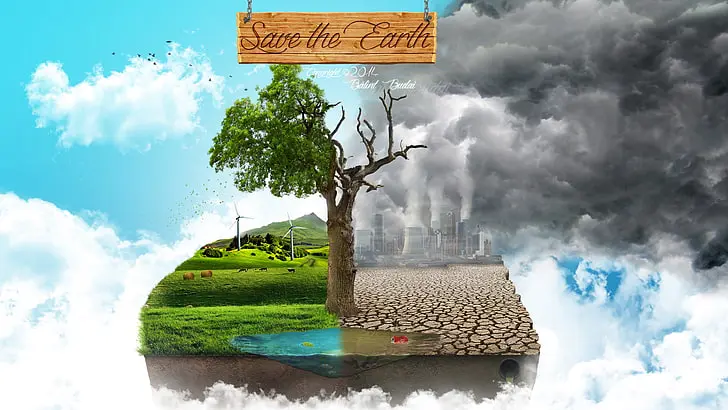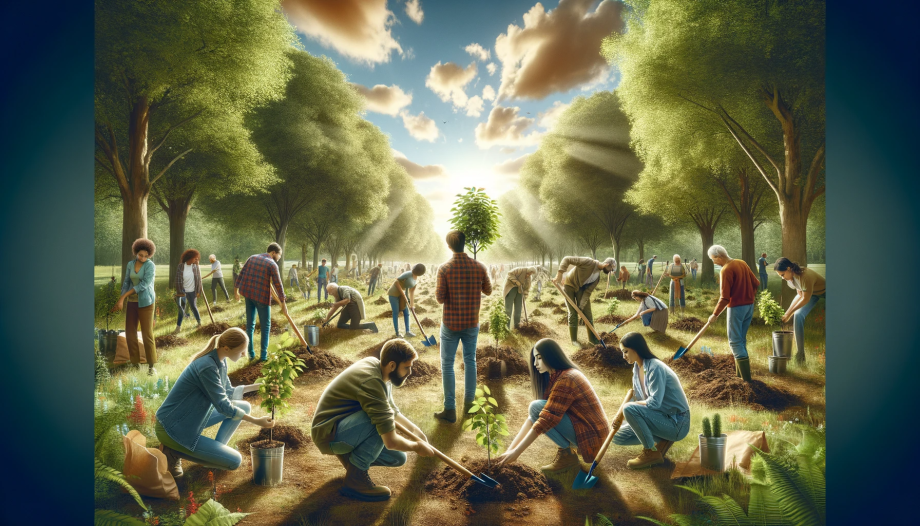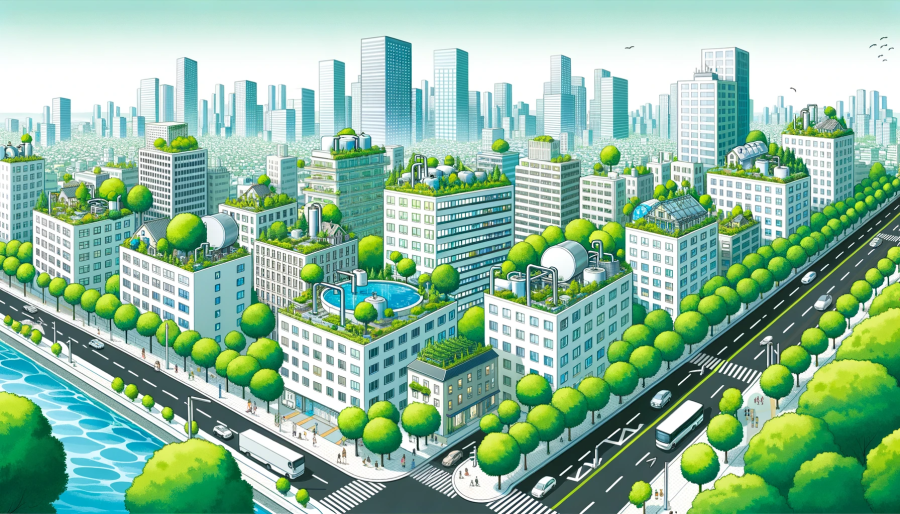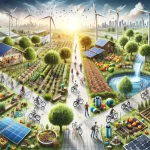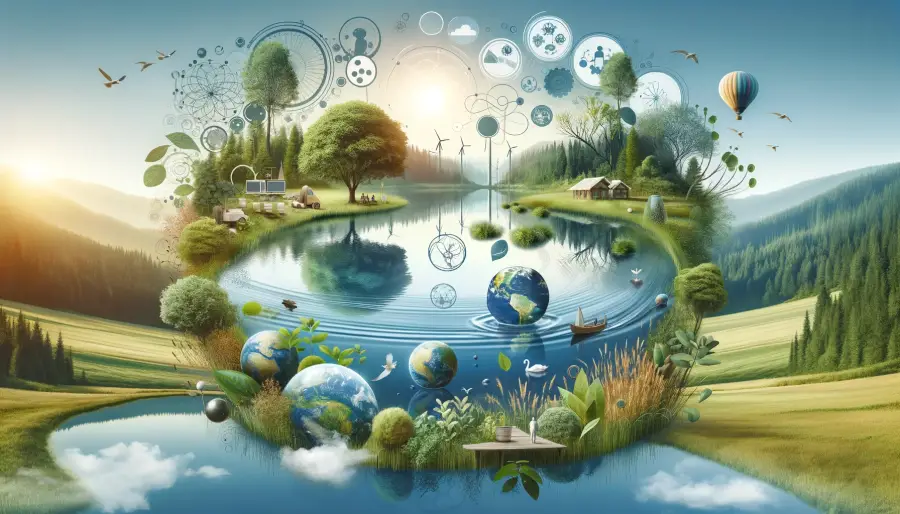
Explore the intersection of sustainable development and the environment, where progress meets preservation and future generations thrive.
Imagine a world where every innovation blooms in harmony with nature. That’s where sustainable development and the environment dance together in perfect rhythm.
Join us on a journey to discover how we can grow our communities while tenderly caring for the Earth.
Sustainable Development Key Takeaways:
- Sustainable development and the environment focus on meeting human needs while preserving natural resources.
- It’s a strategy ensuring economic growth doesn’t compromise our ecological balance, integrating environmental protection with societal progress.
Sustainable Development and the Environment
Welcome to the green side of life, where aligning sustainability goals with environmental protection isn’t just a dream—it’s our mission. Join us as we explore innovative ways to live in harmony with nature, ensuring a vibrant future for all.
Environmental sustainability goals are like a compass, guiding our journey towards a healthier planet. These goals are not just about preserving nature but about creating a future where everyone thrives. They’re about balancing our needs today without compromising what’s left for tomorrow’s generations. It’s a big task, one that calls for cooperation across nations, industries, and communities. In this article, we’ll dive into what these goals are, why they matter, and how we can all play a part in this vital global mission.
Overview of the 17 SDGs
Picture the world as a large, interconnected system. Every part, from the smallest individual action to global policies, plays a role in shaping our future. In 2015, world leaders crafted a plan with 17 Sustainable Development Goals (SDGs) at its heart. These goals aim to tackle the globe’s most pressing challenges by 2030. We’re talking about big issues here—poverty, hunger, and protecting the planet. It’s a bold call to action for all countries to join hands for peace and prosperity for people and the planet.
In 2015, the United Nations General Assembly (UNGA) created the SDGs as part of the Post-2015 Development Agenda. This agenda sought to design a new global development framework, replacing the Millennium Development Goals, which were completed that same year. These goals were formally articulated and adopted in a UNGA resolution known as the 2030 Agenda, often informally referred to as Agenda 2030. On 6 July 2017, the SDGs were made more actionable by a UNGA resolution that identifies specific targets for each goal and provides indicators to measure progress. Most targets are to be achieved by 2030, although some have no end date.
https://en.wikipedia.org/wiki/Sustainable_Development_Goals
Deep Dive into Each SDG
Let’s zoom in on a couple of these goals to get a clearer picture. Starting with Goal 1, “No Poverty,” the aim is to pull the brakes on poverty in all its forms. It’s a massive challenge, with around 736 million people living on less than $1.90 a day as of 2015. Then there’s Goal 2, “Zero Hunger,” which is all about ending hunger, achieving food security, and improving nutrition. This goal is crucial, as millions still go to bed hungry each night.
For each of these goals, there are specific targets and actions in place. They’re designed to address not only the symptoms but also the root causes of these global issues. From improving access to clean water and sanitation to ensuring quality education for all, the SDGs cover a wide range of interconnected issues.
Dive into Each 17 SDGs
The Sustainable Development Goals (SDGs) are a call to action to end poverty, protect the planet, and ensure all people enjoy peace and prosperity. Each goal addresses a specific challenge and contributes to the overall vision of sustainability.
Goal 1: No Poverty – Targets and Progress This goal aims to eradicate poverty in all forms by 2030. It’s a hefty target, and progress has been made, but challenges persist due to issues like income inequality and lack of access to essential services.
Goal 2: Zero Hunger – Challenges and Objectives Zero Hunger seeks to end hunger, achieve food security, and promote sustainable agriculture. Progress has been uneven, with some regions making significant strides while others still struggle due to conflicts and climate change.
SDG Goals 3-17
- Goal 3: Good Health and Well-Being – Focuses on ensuring healthy lives through universal healthcare, reducing fatalities from common diseases, and promoting mental health.
- Goal 4: Quality Education – Aims to provide inclusive, equitable, quality education and promote lifelong learning opportunities for all.
- Goal 5: Gender Equality – Strives to achieve gender equality, empower all women and girls, and end all forms of discrimination.
- Goal 6: Clean Water and Sanitation – Targets accessible and sustainable management of water and sanitation for all.
- Goal 7: Affordable and Clean Energy – Seeks to ensure access to affordable, reliable, sustainable, and modern energy.
- Goal 8: Decent Work and Economic Growth – Promotes sustained, inclusive economic growth, full and productive employment, and decent work.
- Goal 9: Industry, Innovation, and Infrastructure – Builds resilient infrastructure, promotes inclusive and sustainable industrialization, and fosters innovation.
- Goal 10: Reduced Inequality – Aims to reduce inequality within and among countries.
- Goal 11: Sustainable Cities and Communities – Seeks to make cities and human settlements inclusive, safe, resilient, and sustainable.
- Goal 12: Responsible Consumption and Production – Ensures sustainable consumption and production patterns.
- Goal 13: Climate Action – Calls for urgent action to combat climate change and its impacts.
- Goal 14: Life Below Water – Focuses on conserving and sustainably using the oceans, seas, and marine resources.
- Goal 15: Life on Land – Aims to protect, restore, and promote sustainable use of terrestrial ecosystems, manage forests, combat desertification, and halt and reverse land degradation and halt biodiversity loss.
- Goal 16: Peace and Justice Strong Institutions – Promotes peaceful and inclusive societies for sustainable development, provides access to justice for all, and builds effective, accountable, and inclusive institutions.
- Goal 17: Partnerships to achieve the Goal – Strengthens the means of implementation and revitalizes the global partnership for sustainable development.
These concise explanations for goals 3-17 provide a snapshot of each objective, recognizing that detailed strategies and targeted actions are required to achieve these ambitious goals.
The Environmental Dimension of SDGs
When we talk about sustainability, we can’t ignore the environmental aspect. It’s the foundation that supports everything else. The environmental goals within the SDGs remind us that without a healthy planet, we can’t have healthy people. They call for urgent action on climate change and ask us to safeguard our oceans and forests. It’s about understanding that every choice we make, from the food we eat to the energy we use, impacts the environment.
FAQs on Sustainable Development and the Environment
Navigating the path to a greener future sparks a lot of questions. What are environmental sustainability goals? Why do they matter to us? Here, we’ve gathered some of the most common inquiries to shed light on how these goals are the blueprint for our planet’s future well-being. Before we dive deeper, let’s answer some common questions about environmental sustainability goals.
Q: What exactly are environmental sustainability goals?
A: They’re targets set to ensure that we meet human needs while preserving the environment, so that these needs can be met not only in the present, but also for future generations.
Q: Why are these goals important for us?
A: They’re crucial because they address the urgent environmental, social, and economic challenges facing our world. Without achieving these goals, our planet’s ecosystems, which we rely on for air, water, and food, may become irreversibly damaged.
Q: How can we contribute to achieving these goals?
A: Everyone can contribute by reducing waste, conserving energy, using sustainable transportation, and supporting policies and products that are eco-friendly. Every small action, when multiplied by millions, can lead to significant change.
Q: What is the impact of not meeting these goals?
A: Failing to meet these goals could result in exacerbated climate change, resource depletion, and loss of biodiversity, leading to severe consequences for human health, livelihoods, and global stability.
Before we dive deeper, let’s answer some more common questions about environmental sustainability goals.
Q: What is Sustainable Development?
A: Sustainable development is about meeting our own needs without compromising the ability of future generations to meet theirs. It’s about finding a balance where everyone can have access to the resources they need, like food and water, without harming the planet.
Q: What is the 2030 Agenda?
A: The 2030 Agenda is a global action plan adopted by United Nations member states. It’s a commitment to end poverty and other deprivations while also improving health, education, reducing inequality, and tackling climate change.
Q: What are the SDGs?
A: The SDGs are 17 goals set by the United Nations to guide our path towards a more sustainable future. They cover areas like health, education, and climate action, and each has specific targets to be achieved by 2030.
Q: Why is the environmental dimension crucial for the Agenda’s success?
A: The environment is a pillar of sustainable development. Protecting our natural resources ensures we have the essentials for life – clean air, water, and food. It’s also about preventing the worst effects of climate change, which can undo progress in other areas.
Implementing the Environmental Sustainability Goals
But it’s not just about the big players; every person has a stake in this. Imagine if each of us planted a tree, saved water, reduced waste, or chose public transport. These small actions add up. Think global, act local—that’s the mantra. Education plays a key role, too. When people understand the impact of their actions, they’re more likely to change. Schools, media, and communities can spread the word, making sustainability a part of our daily lives.
Government Policies and Global Agreements
Government policies are the steering wheel that guides the nation towards sustainability. They can incentivize renewable energy, enforce regulations to protect natural resources, and fund research for sustainable technologies. Global agreements, like the Paris Agreement, unite countries under common environmental goals, pushing for a collective effort against climate change. Such pacts are crucial as they set international standards and hold countries accountable, fostering a sense of global responsibility for our planet’s health.
Corporate Responsibility and Innovation
Businesses have a unique power to drive significant environmental change. By aligning with SDGs, companies can reduce their ecological footprint through green supply chains, energy-efficient operations, and sustainable product design. Innovative corporate strategies, like using renewable materials or investing in carbon offset projects, showcase a commitment to the planet while often improving profitability. These actions signal to consumers and competitors alike that sustainability and business success go hand in hand.
Community Initiatives and Education
Communities are the grassroots of sustainability, where change is palpable. Local initiatives, like community gardens or recycling programs, empower citizens to act and make a tangible difference. Education amplifies this impact. By integrating sustainability into curriculums, hosting workshops, and sharing success stories, communities can foster an ethos of environmental stewardship, ensuring that sustainable practices continue to grow from the ground up.
Individual Actions and Lifestyle Choices
Every choice we make has a ripple effect on the environment. Choosing a plant-based meal, cycling to work, or simply turning off unused lights can lower our carbon footprint. When we multiply these individual actions by millions, the cumulative effect can be profound. Embracing sustainable lifestyles can lead to a groundswell of support for environmental policies, influencing larger systemic changes and propelling society towards the SDGs.
The Path Forward: Action and Innovation
Innovation isn’t just about high-tech gadgets; it’s about creative solutions to old problems. It could be as simple as a new way to collect rainwater or as complex as a new clean energy grid. The path forward is also about sharing knowledge—what works in one place might inspire action in another. And while we innovate, we must also preserve. Traditional knowledge, like indigenous farming practices, can teach us a lot about living in harmony with nature.
Technological Advances and Renewable Energy
The leap forward in renewable energy technologies is reshaping our approach to power generation. Breakthroughs like more efficient solar panels and wind turbines, battery storage advancements, and smart grids are making green energy more accessible and reliable than ever. On the tech front, sophisticated software helps track SDG progress, analyze environmental data, and optimize resource use. These technologies are not just tools but allies in our quest for a sustainable future.
Sustainable Agriculture and Food Security
Innovative farming methods, such as precision agriculture, hydroponics, and vertical farming, are revolutionizing how we grow food. These techniques maximize yield while minimizing environmental impact, playing a crucial role in achieving SDGs related to hunger and sustainable land use. By creating resilient food systems that use less water, land, and energy, we’re taking vital steps toward food security and a sustainable future.
Conservation Efforts and Biodiversity Protection
Protecting our planet’s rich biodiversity is more than a moral duty; it’s essential for survival. Conservation efforts like creating protected areas, restoring natural habitats, and enforcing wildlife trade regulations are critical strategies. They maintain ecological balance and the health of ecosystems upon which we depend. By safeguarding biodiversity, we ensure natural resilience against climate change and preserve the natural heritage for future generations.
Circular Economy and Waste Reduction
The circular economy redefines our traditional take-make-waste industrial model to a sustainable one by designing out waste and keeping materials in use. It’s an economic system where products are reused, repaired, and recycled. This shift to a circular economy not only reduces waste but also conserves resources, lowers greenhouse gas emissions, and can lead to innovation in product design and service models that prioritize sustainability.
Sustainable Development and Environment Conclusion
In closing, the SDGs give us a blueprint for a sustainable future, but it’s up to us to follow it. Sustainability isn’t a box to check; it’s a journey. We must be willing to learn, adapt, and persevere. It’s a challenge, but also an opportunity—an opportunity to build a world that’s not just surviving, but thriving. It’s a chance to hand over a planet to our children that’s in better shape than we found it.
Ongoing Learning and Adaptability
The path to sustainability is paved with continuous learning. As new challenges emerge, staying informed and adaptable is crucial. It means being open to new ideas and ready to shift strategies when necessary. Ongoing education in sustainable practices encourages innovation and fosters a mindset ready for change. Embracing this adaptability ensures that as the world evolves, so too do our efforts to protect it.
Global and Local Synergy
Local actions are the building blocks of global sustainability. When a community conserves water, recycles, or uses renewable energy, it contributes to global goals. These local efforts, when replicated and scaled, can lead to significant international impacts. The synergy between local initiatives and global objectives underscores the interconnectedness of our efforts to achieve the SDGs.
Future Outlook and Youth Engagement
Youth engagement is vital for a sustainable future. Young people bring fresh perspectives, energy, and a sense of urgency to the sustainability movement. They are not just future leaders but active contributors today. By involving youth in decision-making and sustainability initiatives, we tap into their innovative spirit and ensure that the journey towards sustainability continues with the next generation.

